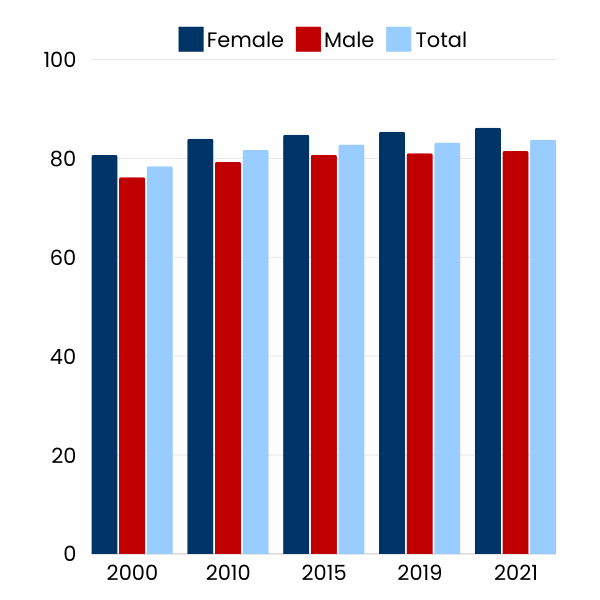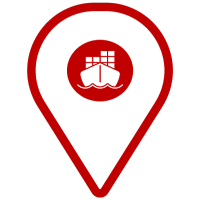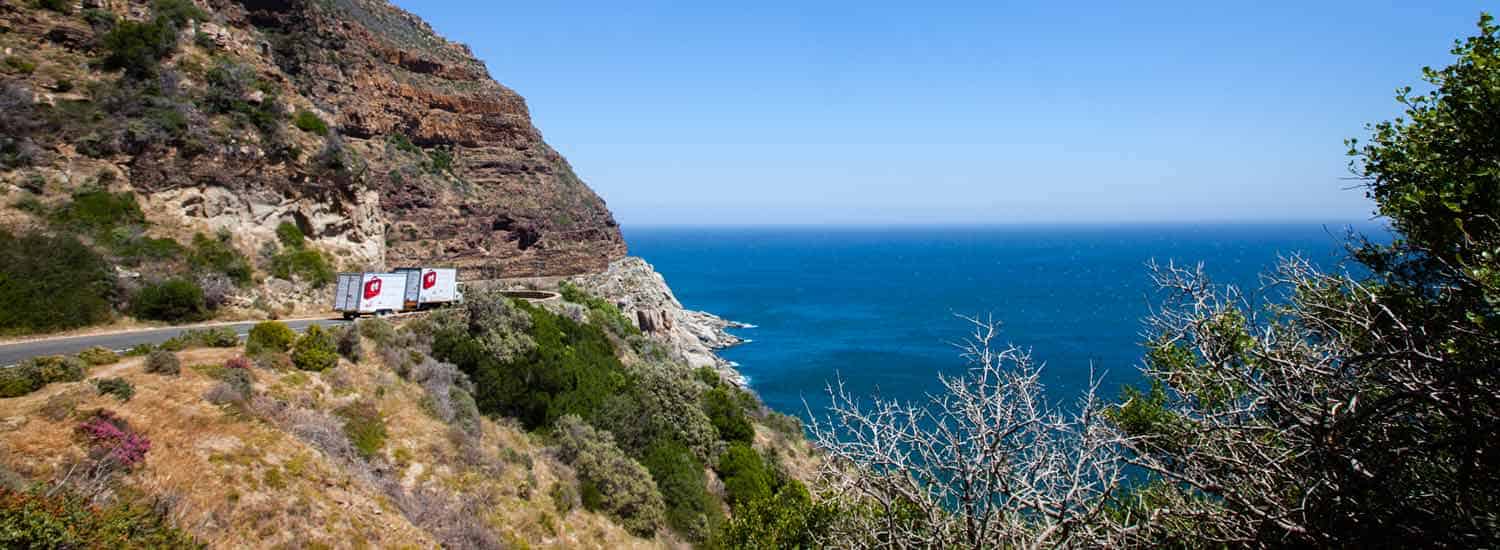Before packing, check this list of items prohibited from entering a particular country or region.

Table of contents
- Information about Singapore
- Relocating pros and cons
- Applying for a visa
- Singapore living costs
- Where to live in Singapore
- Renting vs. buying
- Opening a bank account
- Getting a job in Singapore
- Singapore education system
- Singapore healthcare
- Singaporean transport
- Singapore culture
- Shipping to Singapore
- Extra resources

Things to know before moving to Singapore
Moving to Singapore is an exciting adventure for expats eager to experience a blend of modern innovation and deep-rooted traditions. Known for its futuristic architecture, lush green spaces and ancient temples, the Lion City offers a unique lifestyle that balances fast-paced urban energy with natural serenity.
Singapore's population has steadily grown in recent years, reaching over 5.9 million people, driven by a mix of returning citizens and a significant expatriate community. A strong economy, high-quality education system and world-class healthcare services support the proud nation's growth.
This guide will cover everything you need to know about moving to Singapore, from navigating the visa process to finding a new home, understanding how far your money will stretch, finding a job, and much more.
Is Singapore a good place to live?
Singapore is a good place to live, boasting one of the highest standards of living in the world. Residents benefit from a safe, clean and scenic environment, a highly efficient public transport system, and a diverse, multicultural society. The city-state is also known for its eclectic food scene, dazzling skyscrapers and thriving arts and entertainment options.
Must-know information about living in Singapore

Quick facts about Singapore
| Islands and inlets | 64 |
| Capital | Singapore |
| Population | 5.92M |
| Official languages | English, Malay, Mandarin and Tamil |
| Area | 284.0 mi² (735.6 km²) - 176th largest in the world |
| Currency | Singapore Dollar (SGD) (S$) |
| Form of government | Unitary parliamentary republic |
| GDP (total) | S$794.18B |
| GDP (per capita) | S$133,737 |
| Human Development Index (HDI) | 0.949 - 9th in the world |
| Time zone | GMT +8 |
Sources: singstat.gov.sg, visitsingapore.com, imf.org, hdr.undp.org
...the Lion City offers a unique lifestyle that balances fast-paced urban energy with natural serenity.
Singapore districts


Pros and cons of living in Singapore
Singapore is a captivating destination that seamlessly blends modern innovation with deep-rooted traditions, making it an exciting place to live and work. However, like any country, it has its good and bad points. So, here are some positives and potential challenges to consider before making the big move to Singapore.

World-class healthcare:
The city-state boasts one of the world's best-rated healthcare systems, including excellent medical facilities and highly trained professionals. Enjoy public and private healthcare options known for their efficiency, short waiting times and advanced medical technology.
A safe place to call home:
Singapore is renowned for its exceptionally low crime rates, making it one of the safest countries globally. Strict law enforcement, a robust legal system and a culture of community vigilance contribute to the country's reputation as a secure and peaceful place to live.
Enjoy a multicultural society:
As a melting pot of cultures, the expat haven is home to diverse traditions and lifestyles. The harmonious blend of ethnic groups includes Chinese, Malay, Indian and Eurasian communities. Experience a wide variety of languages, festivals and culinary delights.
Work in a thriving economy:
Singapore's robust and resilient economy makes it an attractive destination for professional expats, especially those in the finance, technology and healthcare sectors. Low taxes and supportive government policies also make it desirable for entrepreneurs and investors.
Exceptional public transport:
Singapore's public transport system is renowned for its efficiency, reliability and affordability. With an extensive network of buses, Mass Rapid Transit (MRT) trains and taxis, getting around the city is straightforward and convenient, reducing the need for pricey car ownership.

High cost of living:
While Singapore offers many benefits, it comes at a price. The cost of living is one of the world's highest, particularly for renters after the post-COVID-19 surge. Daily essentials like groceries and dining out can be pricey, and owning a car is very costly due to high taxes and the Certificate of Entitlement system.
Strict rules and regulations:
Laws like the chewing gum ban, littering penalties (up to S$1,000/around US$765.47 for first-time offenders and S$2,000/around US$1,530.94 for repeat offenders) and jaywalking fines contribute to Singapore's clean and orderly environment but can feel restrictive.
Hot and humid climate:
Singapore's tropical climate means year-round heat and humidity, which can be challenging for those unaccustomed to it. Temperatures rarely dip below 25°C, and humidity can be intense, particularly during the monsoon season, which also brings heavy rainfall.
Limited personal space:
As a small island and city-state, space is at a premium, so it may feel clustered and noisy if you arrive from a more spacious country. Accommodation can be small and expensive, and public areas, including transport and parks, are often crowded, particularly during peak times.
Stringent immigration process:
Obtaining long-term residency or citizenship takes time and effort. The process requires meeting strict criteria, such as sufficient educational and professional experience, two years of mandatory national service for boys at age 18 and a lengthy application.
Is it hard to move to Singapore?
Moving to Singapore can be complex and varies depending on your passport, work and educational experience, family connections in the city-state, and whether you plan to find employment or study.
Another critical factor is how to transport your belongings to Singapore. The easiest way is to hire a professional overseas removals company who can provide a self-loading moving pod like the Seven Seas Worldwide MoveCube®.

Singapore visa process: everything you need to know
Getting a visa to live and work in Singapore depends on your nationality and the purpose and length of your stay.
The Immigration & Checkpoints Authority (ICA) is responsible for visas, immigration, and citizenship in Singapore. Citizens of many countries, including the USA, UK, the Association of Southeast Asian Nations (ASEAN), and EU member states, have a visa waiver agreement with Singapore, with over 160 nations not needing a visa for short visits (up to 30 or 90 days, depending on nationality).
Countries that require a short-stay visa include Russia, India, Pakistan, Egypt, Saudi Arabia and Afghanistan.
Citizens of many countries, including the USA, UK, the Association of Southeast Asian Nations (ASEAN), and EU member states, have a visa waiver agreement with Singapore...
How to move to Singapore
To move to Singapore, all residents and non-residents must first apply online for a Singapore Arrival Card (SGAC), which details your travel history and health status. Exceptions are those passing through the country on a connecting trip and residents crossing the border by road between Singapore and Malaysia.
Then, you must apply for a long-term visit pass to stay in Singapore longer than 90 days. The Ministry of Manpower (MOM) overseas work visas and related matters. There are several types of work passes, including:
- Employment Pass (EP): for professionals, managers, executives, and specialists earning a minimum monthly salary of S$5,000* (around US$ 3,827).
- S Pass (SP): for skilled workers (e.g., associate professionals and technicians) who may not meet the EP requirements and earn at least S$3,000* (around US$2,291) per month.
- EntrePass: for entrepreneurs looking to start and operate a business in Singapore that has financial backing or involves innovative technologies.
- Personalised Employment Pass (PEP): for high-earning EP holders, offering greater flexibility.
Eligible relatives can apply for a family visa, such as:
- Dependent's Pass: for spouses and children of EP or SP visa holders who wish to join them in Singapore.
- Long-Term Visit Pass (LTVP): for common-law spouses, step-children or disabled children of an EP or SP visa holder.
Other options include:
- Student Pass (STP): for students studying for up to four years. Under certain conditions, students may bring family members to Singapore.
- Permanent Residency (PR): for those looking to settle in Singapore permanently. You must be either a spouse of a PR or citizen, a citizen's parent, a holder of an SP or EP visa, a student, or a foreign investor.
*prices accurate as of 2024

How to apply for a Singapore visa
To apply for a Singapore visa, submit your application online through the ICA or the MOM websites. Typical documents you'll need to provide include:
- A valid passport.
- A completed application form.
- A recent passport-sized photograph.
- Proof of accommodation.
- A return or onward journey ticket.
- Proof of sufficient funds.

Processing times and fees vary depending on the type of visa you choose and the duration of your stay in Singapore. Ensure you pay the correct fee as instructed on the application portal. Once approved, you'll receive an In-Principle Approval (IPA), which, depending on your visa, includes conditions for entry, such as medical exams.
Once you arrive in Singapore, ensure you have all required documents, including your visa (if applicable), passport and additional supporting documents.
What percentage of Singapore's population are immigrants?
Immigrants are
40% of Singapore's population
Source: Statista
Can I retire in Singapore?
You can retire in Singapore, but it requires careful planning. While Singapore doesn't offer a retirement visa, you can obtain permanent residency via work, family connections or significant investments. To supplement your golden years in Singapore, ensure you have enough money to combat the high cost of living. Non-residents can use the Supplementary Retirement Scheme (SRS) for tax relief on contributions towards their overseas retirement.

Cost of living in Singapore
As the fifth wealthiest city in the world, Singapore's cost of living is high, so ensure you budget for accommodation, utilities, education, transport, entertainment, and food before moving. Housing will likely be your biggest expense, with rental prices in areas like Nassim Road, Marina Bay, and Ardmore Park being particularly steep.
On the plus side, Singapore's living standards are also high. Healthcare is universal and of excellent quality, crime rates are very low, there's long-lasting political stability, and the economy is considered one of the most competitive in the world.
How much does moving to Singapore cost?
The money you'll need to move to Singapore depends on your personal situation. However, typical considerations include visa application and medical appointment fees, flights (use comparison tools like Skyscanner and Google Flights), temporary accommodation (utilise rental sites like 99.co and PropertyGuru) and overseas removal costs.
Singapore's living costs vary based on location, lifestyle and family size. Unemployment is low, and while there is no official minimum wage, Singapore uses the Progressive Wage Model (PWM) to help uplift workers' incomes via upskilling and productivity measures.
Essential utilities, such as heating and water, cost roughly S$218 (around US$167) per month; use energy comparison websites like Open Electricity Market and GetSolar to research the best prices. Public transport costs about S$120 (around US$92) monthly and is an affordable alternative to driving.
Singapore employment rate:

Source: stats.mom.gov.sg

Price of everyday items in Singapore
Below are average prices* in Singapore dollars (S$) for some everyday items and entertainment options in Singapore:

*prices accurate as of 2024

Where to live in Singapore
Singapore is divided into several districts, each with multiple planning areas (PA) and unique characteristics and living conditions. Here is our guide to the best places to live in Singapore, including big city vibes, the tranquillity of suburbia and dreamlike tropical islands.
![]()
1. Central Region
Singapore's main metropolitan area includes prime spots like Orchard Road, known for luxury shopping and high-end properties, and Marina Bay, with its iconic landmarks and bustling business centre.
The area is also home to the country's sole UNESCO World Heritage Site, the Singapore Botanic Gardens, a 165-year-old tropical paradise featuring a mini-rainforest and orchid garden.
Population: 922,580
Population density: 7,000/km2 (18,000/sq mi)
Area: 132.7 km2 (51.2 sq mi)
Avg. monthly rent (for a 3-bed apartment): S$8,000
Most populous PA: Bukit Merah
Unmissable attractions: try your luck at the Marina Bay Sands Casino, experience the bustle of Bugis Street and gawp at the Gardens by the Bay light show.


![]()
2. North Region
The North Region, the second-largest region in terms of land area, includes suburban districts such as Yishun and Woodlands. It's home to the Woodlands Regional Centre, a key commercial hub, and the Sembawang Shipyard, one of the city's biggest employers.
Blooming with leafy neighbourhoods and tranquil forest trails, the North Region feels worlds away from Singapore's centre, enjoying fresher air and lower rents.
Population: 582,330
Population density: 4,330 per km² (11,000/sq mi)
Area: 134.5 km2 (51.9 sq mi)
Avg. monthly rent (for a 3-bed apartment): S$2,500
Most populous PA: Woodlands
Unmissable attractions: soak in a natural hot spring, kayak through mangroves on the Khatib Bongsu River, and take a night safari at Singapore Zoo.
![]()
3. East Region
Despite being the smallest, the East Region is one of Singapore's most densely populated areas, housing both Changi Airport and Paya Lebar Air Base.
However, the region is a quieter corner of the city, boasting a laid-back residential vibe. Colourful properties from the country's colonial past jostle among modern malls, acres of parkland and long stretches of sandy shorefront.
Population: 685,890
Population density: 7,400/km2 (19,000/sq mi)
Area: 93.1 km2 (35.9 sq mi)
Avg. monthly rent (for a 3-bed apartment): S$2,880
Most populous PA: Bedok
Unmissable attractions: savour traditional dishes in the Geylang Serai Market, marvel at the treasures in Katong Antique House and cycle through East Coast Park.


![]()
4. North-East Region
The North East is the city's most densely populated region, notable for its rapid urbanisation since the 1970s. It features many high-rise HDB estates and excellent transport links to the centre of Singapore, making the area popular with young couples and families.
Although super-modernised, the region is still rich in rustic charm with plenty of green spaces and waterfront walks.
Population: 930,910
Population density: 9,000/km2 (23,000/sq mi)
Area: 103.9 km2 (40.1 sq mi)
Avg. monthly rent (for a 3-bed apartment): S$2,700
Most populous PA: Sengkang
Unmissable attractions: try prawning at Punggol Promenade, go birdwatching on Coney Island and say a prayer at one of Singapore's oldest Hindu temples.
![]()
How many islands does Singapore have?
Singapore currently has 64 islands, including the mainland, Singapore Island, which is separated from the peninsula of Malaysia by the Johor Strait.
These islands and islets vary in size and population — here are some of the most popular:
- Sentosa Island: a major resort destination known for its stunning golden beaches, luxury hotels, and tourist attractions like Universal Studios Singapore and the S.E.A. Aquarium.
- Pulau Ubin: this rustic island, sitting off the mainland's northeast coast, is adored for its untouched natural beauty and rich biodiversity, which visitors can explore on bikes or by foot.
- Kusu and Lazarus Islands: known as "the Sisters" by Singaporeans, both islands provide a tranquil escape from the city's hubbub. From exploring ancient temples to snorkelling in crystal-clear waters, they are a must-visit for those seeking a peaceful beach getaway.
![]()
5. West Region
A region of contrasts, the West of Singapore is a blend of heavy industry (especially in the areas of Jurong and Tuas) and residential complexes nestled amongst lush forests.
An up-and-coming region earmarked for significant development, the West Region is a favourite of students because it is home to several of the city's highest-ranking educational institutions, including Nanyang Technological University (NTU) and the National University of Singapore (NUS).
Population: 922,540
Population density: 4,600/km2 (12,000/sq mi)
Area: 201.3 km2 (77.7 sq mi)
Avg. monthly rent (for a 3-bed apartment): S$4,380
Most populous PA: Jurong West
Unmissable attractions: discover dinosaurs at the Lee Kong Chian Natural History Museum, sip on a cold one at the Tiger Brewery and watch the sunset beside the Raffles Marina Lighthouse.
Sources: citypopulation.de, singstat.gov.sg
Cheapest place to live in Singapore
The cheapest place to live in Singapore is Ang Mo Kio, according to a recent study by the online learning platform Preply. The average price of a one-bedroom condo is S$1,268* (around US$974) per month.
In contrast, less than four miles south sits Toa Payoh, the most expensive area. Rent here costs S$5,007* (around US$3845) per month, a whopping 93% of Singapore's average household income.
*prices accurate as of 2024
![]()
HDB flats vs condos: price comparison
Below is a comparison of the average monthly rental prices* for HDB flats against private condos for three key regions in Singapore.
Central Region
| HDB flat (per month) | Condo (per month) | |
| Studio | S$3,250 | S$9,675 |
| 2-bedroom | S$3,250 | S$11,250 |
| 3-bedroom | S$6,250 | S$17,900 |
North Region
| HDB flat (per month) | Condo (per month) | |
| Studio | S$2,100 | S$2,350 |
| 2-bedroom | S$2,450 | S$2,850 |
| 3-bedroom | S$3,600 | S$5,250 |
West Region
| HDB flat (per month) | Condo (per month) | |
| Studio | S$2,450 | S$2,800 |
| 2-bedroom | S$2,600 | S$3,600 |
| 3-bedroom | S$3,090 | S$4,800 |
*prices accurate as of 2024
Sources: propertyguru.com.sg

Renting in Singapore
Start by researching the regions you're most interested in to understand rental prices, transport options, local amenities and crime rates. Rental comparison sites like PropertyGuru and rentinsingapore.com.sg are great resources for detailed listings and price comparisons. Several dedicated Facebook groups offer rentals for students, professionals and various expat communities.
However, when considering a home, don't rely solely on what you see online. Visit the property in person to better understand its condition, layout, and surrounding area and to have the opportunity to ask the landlord or agent additional questions.
Top tip: some property comparison sites offer instant, customised alerts for new listings. This handy feature can help you stay ahead of the competition!
Keep a close eye out for Housing and Development Board (HDB) rentals — affordable public housing managed by the government. Eligible tenants, including Singaporeans and low-income Permanent Residents, can choose from various flat sizes. Rental prices are cheaper than private properties, and leases typically last 2 to 3 years.
Once you've chosen a property you like, submit a rental application to the landlord or their representative and provide identification and proof of your right to stay in Singapore, such as a work pass or student pass. This step often includes a negotiation over price.
Next, send a Letter of Intent (LOI) indicating that you wish to take the property and are no longer looking at other homes. An LOI is often accompanied by a good faith deposit, which will be your security deposit once you secure the property.
Then, pay the rental stamp duty, which is 0.4% of the total rent for up to four years, document any existing damage with photos, and conduct a final inspection.
Finally, the landlord will create a tenancy agreement for you to review and sign, detailing important information such as the rent amount, lease duration, pet rules, subletting, etc. After signing, pay the security deposit, generally one month's rent per year of your agreed lease, if you didn't pay a good faith deposit. Once all payments are processed, you'll receive a receipt and the keys to your new home!
Buying a house in Singapore as a foreigner
Create a budget to determine whether you can afford a mortgage. For private properties, you'll need a down payment of at least 5% of the purchase price and 20% for HDB homes.
For non-Singapore citizens, companies, limited liability partnerships, or societies, you must seek government approval to buy specific properties, such as vacant land, terrace houses and bungalows. Approval is awarded case-by-case, often requiring the applicant to be a permanent resident for at least five years. However, foreigners do not need approval to purchase properties like condominium units, flats and commercial or industrial properties.
Foreign buyers are also subject to a 60% Additional Buyer's Stamp Duty (ABSD) in addition to the standard Buyer's Stamp Duty (BSD). Stamp duty must be paid in cash upfront and cannot be deferred. There are no ABSD charges for US nationals and nationals/PRs from Switzerland, Liechtenstein, Norway or Iceland who are buying their first residential property.
View as many properties as possible using popular sites like EdgeProp, PropertyGuru, and SRX Property, and ask the estate agent detailed questions. One option is to hire a property agent to help you scout for the best deals, work out what you can afford, offer insider knowledge, and deal with paperwork. Property agents typically charge a fee of around 1% for finding you a new home.
Next, get an in-principle approval from a bank to understand the maximum amount you can borrow, likely 75% of the purchase price. Singapore banks that loan to expats include Standard Chartered, Citibank, CIMB and Hong Leong Finance.
The bank will evaluate:
- Your credit history.
- Your income and employment.
- Your debt-to-income ratio.
- The down payment you can afford.
- Information on the property you wish to buy.
- Legal and compliance checks.
When you decide to make an offer, and it's accepted, both parties will sign a Sales and Purchase Agreement, formalising the terms of the sale. Then, pay the deposit and hire a conveyancing lawyer to ensure all legal requirements are met and a property inspector to assess the home's condition and value.
One option is to hire a property agent to help you scout for the best deals, work out what you can afford, offer insider knowledge, and deal with paperwork.

Banks like DBS and OCBC offer online and mobile banking options, making account management easier for expats.

How to open a bank account in Singapore
To open a bank account in Singapore as an expat, visit local branches and research thoroughly online. Trusted banks include DBS, OCBC, UOB Group, and Standard Chartered.
Consider factors such as fees for international transfers, minimum balance requirements, and the availability of digital banking services. Banks like DBS and OCBC offer online and mobile banking options, making account management easier for expats.
Required documents typically include a valid passport, proof of address, proof of residence and proof of right to live and work in Singapore, such as an Employment Pass or Student Pass. Some banks may allow you to open an account online, but in-person verification is usually required.
The following are examples of common Singaporean bank accounts:
Current account (often known as a savings account): for daily banking needs, including salary deposits, utility bill payments and money transfers, while earning a small amount of interest. Be mindful of fees and minimum balance requirements.
High-interest savings account: grows your savings with higher interest rates when you meet certain conditions while providing easy access to your funds.
Student account: designed to help students manage their finances. There are typically no minimum balance requirements, low or no fees, and additional perks such as higher interest rates and cashback.
Multi-currency account: ideal for frequent travellers or those dealing in multiple currencies, allowing affordable international transactions.
Investment account: for managing and growing your investments, with options tailored to different risk appetites.

Thanks to a robust economy, there are many opportunities in financial services, electronics, healthcare and IT.
How to get a job in Singapore
Before you begin your job search, it's crucial to understand the conditions of your Singapore Work Pass, which varies depending on your skills and circumstances. For instance, the Employment Pass is for professionals earning at least S$5,000* (around US$3,831) per month, while the S Pass is for mid-level skilled workers.
Next, focus on in-demand industries where your skills and education are valued. Thanks to a robust economy, there are many opportunities in financial services, electronics, healthcare and IT. Emerging opportunities include artificial intelligence, data science and biotechnology. You can find job openings on popular sites like Jobstreet, JobsCentral, and JobsDB.
Consider using a recruitment agency to enhance your chances, such as Manpower (specialising in IT, engineering, and sales) and Robert Half Singapore (finance, technology, and senior management roles), for valuable insights into your target industry.
Tailor your CV for each application, highlighting relevant skills. Ensure your application is in well-written English (the primary business language of Singapore) and include a strong cover letter emphasising your fit for the company. Familiarise yourself with typical employment conditions in Singapore, such as the standard working hours of 9 am to 6 pm and your rights regarding annual leave, public holidays and sick leave.
Networking is crucial. To expand your connections, attend industry events or join professional social groups on Meetup and Facebook.
Finally, the job market in Singapore is very competitive, so be persistent! With the right approach, you can secure a position that fits your qualifications and career goals.
*prices accurate as of 2024

Top 10 jobs in demand in Singapore
According to Indeed, the top 10 jobs in demand in Singapore with the highest annual salaries (in S$) are DevOps engineer, cyber security specialist, communications manager, full stack developer, back-end developer, business analyst, data scientist, robotics engineer, and project manager.
The graph below orders these roles by their expected average earnings in S$.


Singapore education system
Education in Singapore is compulsory for children between the ages of seven and sixteen. Programs nurture the whole child to foster lifelong learning and prepare them for 21st-century life. The curriculum emphasises academic and holistic development, integrating community activities, leadership study, and values-based programmes. The Ministry of Education (MOE) manages curriculums, teacher training, and funding.
You can find and apply to local schools through the official MOE website.
Required enrolment documents include:
- Child's birth certificate.
- Child's passport.
- Immigration documents (e.g., Dependant's Pass, Student's Pass, Long Term Visit Pass).
Parents' passports. - Parents' employment documents (e.g., Employment Pass, Work Permit).
- Child's immunisation records.
- Offer email from MOE (for specific situations).
The education system in Singapore is as follows:
Kindergarten (ages 3-6): optional, consisting of Nursery, Kindergarten 1 (K1), and Kindergarten 2 (K2) to help children develop social, language, and cognitive skills via language learning, number recognition, music, games and outdoor play.
Primary school (ages 7-12): focuses on developing literacy, numeracy, and character development. Core subjects include English, mathematics, languages, art, music, and physical education.
Secondary school (ages 12-16): there are different streams, such as Express, Normal (Academic), and Normal (Technical), to match students' academic progress and interests as they work towards their GCE O-Level, N-Level, or Integrated Programme.


Singapore life expectancy
Singapore has one of the highest life expectancies in the world, often ranking among the top ten globally, thanks to the city-state's advanced healthcare system, high living standards, and strong public health policies.
Plus, as the graph below demonstrates, life expectancy in Singapore continues to rise, increasing by 5.42 years from 78.4 years in 2000 to 83.9 years in 2021.

Source: World Health Organization Data
Public hospitals operate with a degree of autonomy to encourage competition and maintain high standards.
Singapore healthcare system
Singapore's healthcare system is admired globally for its efficiency and excellent results. It has a dual public and private healthcare system, which the Ministry of Health heavily regulates to maintain high standards.
The public healthcare system offers universal coverage for Singaporean citizens and permanent residents via taxes and mandatory savings schemes. However, healthcare services are not 100% free — patients contribute through co-payments designed to prevent the overuse of medical services. Public hospitals operate with a degree of autonomy to encourage competition and maintain high standards.
The following schemes are central to Singapore's public healthcare system:
- Medisave: a compulsory savings plan that deducts a percentage of citizens' or permanent residents' salaries to cover routine medical expenses.
- Medishield Life: a basic health insurance plan covering large medical bills and costly outpatient treatments, such as kidney dialysis.
- Medifund: a safety net for those who cannot afford their medical bills even after using Medisave and Medishield Life.
Private healthcare plays a vital role in Singapore's healthcare system. Ten private hospitals offer a wide range of specialised services for those seeking more personalised care and shorter wait times.
Three groups operate most private hospitals in Singapore: Parkway Holdings, Pacific Healthcare Holdings, and Raffles Medical Group. Expatriates tend to prefer private hospitals because the cost difference between public and private care is insignificant for non-permanent residents.

How to travel in Singapore
Singapore's comprehensive and efficient transportation system allows easy movement across the city-state. The primary modes of transport include the MRT rail network, buses, taxis and ride-hailing apps such as Grab and Gojek. There are also trishaws, ferries and bicycle hires.
The MRT is the most popular mode of transport, with around three million daily passengers, six lines and over 140 stations spanning the entire city. It's known for its cleanliness, safety and punctuality. Services run daily from around 5:00 am to midnight, with trains arriving every few minutes during peak hours. Passengers can purchase tickets for each journey or use stored-value cards like the EZ-link card, which also works on buses.
Buses are equally integral to Singapore's public transport network, with four major operators, SBS Transit, SMRT Buses, Tower Transit Singapore, and Go-Ahead Singapore, running thousands of buses across numerous routes. All buses are air-conditioned and wheelchair-accessible, and fares depend on distance travelled. Services generally operate from 5:30 am to midnight, with some night services available. Like the MRT, buses accept EZ-link cards for payment, tap in, tap out contactless payments (using debit or credit cards) and cash (exact fare only).

Taxis and private hire vehicles are all metered and air-conditioned, and over 15,000 cars are available throughout Singapore. Fares start at roughly S$3.90 (around US$2.99), though surcharges apply during peak hours, late nights, and airport trips. Ride-hailing services operate extensively in the city, offering convenient alternatives to taxis with app-based bookings.
For a more leisurely exploration, trishaws (bicycle-powered rickshaws) provide a nostalgic mode of transport, especially in areas like Chinatown and Little India. Additionally, Singapore's ferry services offer routes to nearby islands and destinations in Malaysia and Indonesia. The city's extensive network of cycling paths, currently over 440 km (273 miles) with plans for many more additions, is an eco-friendly way to get around.
Most foreigners in Singapore don't travel by car due to the significant expenses. In addition to the cost of the vehicle, you'll need to obtain a 10-year Certificate of Entitlement (COE), which is currently a huge S$145,000 (around US$111,115), plus an Additional Registration Fee (ARF) and pay Goods and Services Tax (GST).

Singapore history timeline
Pre-1800s
Singapore, known as Temasek in the 14th century, was a busy trading port that served as an outpost for the Srivijaya and, later, the Majapahit empires.
Early 1800s
In 1819, Thomas Stamford Raffles established a British trading post. Singapore quickly became one of the British Empire's most significant ports for global trade, especially once the Suez Canal opened in 1869.
Late 1800s
Alongside the development of British infrastructure, which included extensive wharves, Singapore's role as a major port expanded rapidly.
Early 1900s
The island fell to Japanese forces during World War II, leading to a brutal occupation lasting from 1942 until 1945. Post-war, Singapore transitioned to self-governance in 1959 with Lee Kuan Yew as its first Prime Minister.
Today
Singapore became an independent republic in 1965 after a brief union with Malaysia in 1963. The nation rapidly industrialised, developing into a global financial centre.

Singapore culture: understanding its values, traditions and food
As a thriving financial hub and long favourite destination for expats, Singapore boasts a fascinating cultural landscape shaped by its past and diverse population.
From historic traditions to modern quirks, the city-state offers a unique living experience:
- Respect for hierarchy: Singaporeans value respect for authority and older generations, evident in personal interactions and the workplace. Addressing people by their titles or surnames is standard practice.
- Cultural melting pot: the city-state is known for its ethnic mix, with Chinese, Malay, Indian, and other cultures coexisting harmoniously. The communal celebration of festivals like Chinese New Year, Hari Raya Puasa, and Deepavali reflect this diversity.
- Can I plug in my electricals?: Singapore uses type G plugs and electrical outlets featuring three rectangular prongs in a triangle pattern. The standard voltage is 230V, and the frequency is 50Hz. If necessary, you can use plug adapters upon arrival. However, they are considered a short-term solution unsuitable for long-term use.
- Culinary delights: the food scene is a major highlight for tourists and locals alike, with street food and hawker centres offering dishes like Hainanese chicken rice, laksa, and chilli crab. The blend of Malay, Chinese, and Indian cuisines creates an exciting culinary culture.
- Kiasu attitude: the term "kiasu", which means "fear of losing", reflects a common attitude in Singapore. For many, it's a way of life that encourages competitive and proactive behaviour in work, sports, and everyday life. Kiasu influences everything from academic performance to queueing behaviour.
- Clean and green: the city is renowned for its orderliness and pristine parks, with strict regulations on littering and a focus on sustainable urban planning. Plentiful green spaces, kids' play parks, and the iconic Marina Bay Sands are all part of the city's commitment to maintaining a neat and pleasant environment.
Fun and surprising facts about Singapore
- Alongside Monaco and the Vatican City, Singapore is one of only three surviving city-states worldwide. Former city-states that have since incorporated into neighbouring countries include Venice, Athens and Tenochtitlan.
- In 2000, Singapore established a Speaker's Corner in Hong Lim Park, similar to London's Hyde Park. Citizens can freely express their views on almost any topic, provided they follow certain rules.
- Singapore has banned the sale, import, and manufacture of chewing gum since 1992 to maintain the city's cleanliness. The ban was introduced after stuck gum caused MRT train doors to malfunction, leading to disruptions.
- The National Orchid Garden in Singapore is home to over 1,000 species and 2,000 hybrids of orchids. It also houses the world's largest display of tropical orchids, attracting botany enthusiasts and tourists from around the world.
- Sentosa Island, now a popular tourist destination, was once named Pulau Blakang Mati, which translates to "Island of Death from Behind" in Malay due to its reputation for pirate attacks and deadly malaria outbreaks.
- You can purchase a luxury car from a vending machine! A 15-story building by Autobahn Motors functions as a giant vending machine, dispensing high-end vehicles like Lamborghinis, Bentleys and Ferraris with just the push of a button.
- The world's first nocturnal zoo, the Night Safari, lets visitors experience the unique behaviour of over 900 animals after dark via walking trails, guided tours, and tram rides. Enjoy a unique journey through lush, open enclosures that mimic the animals' natural habitats.
- As the fourth wealthiest city in the world, Singapore boasts the highest percentage of millionaires per capita, with nearly one in six households having over US$1 million in disposable wealth.
- The city-state is home to one of the world's largest floating stadiums, The Float @ Marina Bay. It's hosted numerous high-profile events, including the National Day Parade and boasts a stunning backdrop of the iconic Marina Bay skyline.
- Singapore has a "no durian" rule on all public transport. The exotic fruit's smell is so intense it was banned in 1984, leading to amusing scenarios of people trying to sneak it in! Despite the ban, durian remains a beloved treat.
A 15-story building by Autobahn Motors functions as a giant vending machine, dispensing high-end vehicles like Lamborghinis, Bentleys and Ferraris with just the push of a button.

4 famous landmarks in Singapore

1. Marina Bay Sands SkyPark:
Perched atop the iconic Marina Bay Sands resort, the SkyPark is one of Singapore's most recognisable landmarks. Designed by renowned architect Moshe Safdie, this boat-shaped marvel has become synonymous with the city's skyline.
SkyPark offers breathtaking panoramic views of Singapore, from the bustling Marina Bay to the rich greenery of Gardens by the Bay.
Take a guided tour to learn about its design and the city's rapid transformation into a global powerhouse.

2. Merlion Park:
Located on Marina Bay's waterfront, Merlion Park is Singapore's iconic half-lion, half-fish statue, designed by artist Lim Nang Seng in 1972. It symbolises the city's origins as a fishing village and its name, "Singapore", which means "Lion City".
The statue, which stands 28 feet tall and weighs 70 tons, attracts visitors from all over the world who come to take photos against the backdrop of the city's skyline.
The area offers scenic views of Marina Bay, making it a must-visit spot for anyone exploring Singapore.

3. Supertree Grove:
Nestled within the vibrant Marina Bay, the Supertree Grove showcases the city's sustainable urban design. The colossal structures, standing up to 164 feet tall, aren't just architectural marvels — they're living vertical gardens that host a rich diversity of tropical plants.
Each Supertree is a self-sustaining ecosystem, incorporating advanced technologies such as photovoltaic cells for solar energy and integrated rainwater collection systems.
Explore the grove from the OCBC Skyway, a suspended walkway that provides awe-inspiring views of the lush gardens below.

4. National Museum of Singapore:
Founded in 1887, the National Museum of Singapore delves deep into the nation's historical and cultural heritage. The architecture is a striking example of the neo-Palladian style, with its impressive façade blending smoothly with modern additions.
Explore a rich tapestry of exhibits, from the island's humble beginnings as a fishing village to its dynamic transformation into a global financial powerhouse.
Notable features include the Singapore History Gallery and the captivating Story of the Forest — a digital installation that reimagines Southeast Asian flora and fauna.

How to move to Singapore
For over 25 years, we've been shipping belongings to hundreds of countries. From Jurong in the west to Changi in the east, we'll safely ship furniture, kitchen appliances, sporting goods, boxes, bags, and more to Singapore. Our expert team, free packing supplies, local knowledge, complimentary storage, and multilingual customer service set us apart from other overseas removal companies.
What is the MoveCube®?
You can ship all your household possessions inside our secure moving pod, the MoveCube®. It acts as your own dedicated container, which we bring to your door for you to fill with sofas, kitchen appliances, bicycles, sports gear, instruments, boxes and more!
You can ship all your household possessions inside our secure moving pod, the MoveCube®. It acts as your own dedicated container, which we bring to your door for you to fill with sofas, kitchen appliances, bicycles, sports gear, instruments, boxes and more!
Each MoveCube® comes with a complimentary Starter Pack. Inside, you'll find a marker pen, a box cutter, a roll of parcel tape, and a tape dispenser to secure your belongings into boxes. Plus, three plastic floor sheets to help estimate what fits inside a Large, Medium, or Small MoveCube®.
You can order several MoveCubes®, but please note that they may arrive on separate days. Get your new and exciting life in Singapore started today with an instant, free quote for a transparent cost breakdown of the entire overseas shipping process.
Another benefit of choosing our international removal service is that we take care of the customs process in Singapore for you. However, there are a few things to keep in mind before making plans.
- Like all countries, Singapore restricts the import of certain items to protect its people and environment. Reference our Prohibited Goods page while packing to avoid delays or fines.
- Complete all your online documents and ensure your inventory (a detailed packing list of all items you're shipping to Singapore) matches what's in the MoveCube(s)®.
- Upload clear, colour scans of the shipment owner's passport picture and signature pages.
- If you're shipping plant life, wood or any animal by-product and their derivatives, ensure they are not endangered as classified by CITES (Convention on International Trade in Endangered Species of Wild Fauna and Flora).
Non-Singapore citizens can import personal belongings without paying Goods and Services Tax (GST). Provisions include being resident overseas for at least six months before moving to Singapore, importing goods within six months of arrival, and possessing one of the following documents:
- Employment Pass (EP)
- In-Principle Approval (IPA) letter from the Ministry of Manpower showing your application status or job offer.
Singaporean citizens and permanent residents are eligible for GST relief provided the items are for personal use, and they have lived overseas for six months (with proof of employment outside of Singapore).
If you have any removal or customs questions, our multilingual customer service team is happy to help.

Transit times for shipping to Singapore
The following are estimated transit times when shipping one Large MoveCube® by sea from the capital cities of some of our most popular routes to Singapore:
| Origin country | Transit time* |
| Australia | 88 days |
| China | 52 days |
| Hong Kong | 54 days |
| Ireland | 144 days |
| Malaysia | 45 days |
| Netherlands | 101 days |
| New Zealand | 103 days |
| South Africa | 103 days |
| Thailand | 84 days |
| United Kingdom | 88 days |
| United States | 111 days |
*estimated timings dependent on global shipping circumstances.
FAQs about moving to Singapore for expats
To apply for a Singapore visa, research short and long-stay visas and working visas on the Immigration & Checkpoints Authority (ICA) website and working visas on the Ministry of Manpower (MOM) website to learn about eligibility and which documents you'll need.
Singapore visas typically take 3 to 5 working days for approval once submitted, although some visa types may require additional processing time. Extended delays can occur if there is a backlog of applications.
Your Singapore visa's validity period depends on its specifics. Before proceeding, thoroughly review the rules and requirements of the visa you intend to apply for.
Visit the official Immigration & Checkpoints Authority (ICA) and Ministry of Manpower (MOM) websites for the most up-to-date information.
The money needed to move to Singapore depends on several factors, including your application fees, neighbourhood, home, lifestyle, family size, and personal needs, such as healthcare.
Expat Frontier estimates that for a single person with moderate lifestyle choices, moving to Singapore costs from S$3,700 to S$8,000 (around US$2,850 to 6,161) monthly.
The best place to live in Singapore depends on your lifestyle, needs, budget and desired amenities. The Central Region is ideal for those seeking luxury and proximity to business hubs in areas like Orchard Road and Marina Bay. Families may prefer the East Region for its quiet streets, good schools and access to Changi Airport. The North-East Region offers a mix of urban living and green spaces, while the West Region is suited for those working in industrial or educational sectors.
Living in Singapore offers a unique blend of modernity and tradition, thanks to bustling urban centres, diverse cultural experiences and efficient public services. Residents enjoy world-class healthcare, a strong job market, an eclectic culinary scene, lush green spaces and a safe, clean environment.
You can move to Singapore without a job if you're joining family, studying, or can make a significant investment.
You can import pets into Singapore, but they must meet specific requirements, including import permits, vaccinations and microchipping. Also, ensure that your pet's breed is not restricted in Singapore.
For the latest information, consult the official Animal & Veterinary Service Singapore website.

Extra resources to help with your move to Singapore

...before making a life-changing decision, it's essential to weigh all the pros and cons of living in Singapore.
Moving to Singapore checklist
Simplify your big move to Singapore with our handy checklist:
- Plan ahead by asking friends, family, and fellow expats for advice: before making a life-changing decision, it's essential to weigh all the pros and cons of living in Singapore.
- Research all applicable visa and residency options: learn about the various entry methods and the visa application process. Then, select your best option for acceptance.
- Run the numbers: check your bank balances to see if you have enough money to support yourself and your family in Singapore for a few months before landing a job and home.
- Choose a neighbourhood and decide to buy or rent: pick a district that suits your family's needs and consider renting first to give yourself time to acclimate.
- Set up new accounts for your bills and savings: open a Singaporean bank account and transfer money from your home country.
- Secure a job: learn about employment etiquette, job-searching methods, application tips and employee benefits in Singapore.
- Organise schooling: enrol your kids in local schools or register to teach them for home.
- Learn about the Singapore healthcare system: decide whether to go private or take advantage of Singapore's publicly-funded, state-run healthcare services.
- Learn how to get around: discover Singapore's efficient, varied, modern and integrated public transport systems.
- Discover Singapore's storied past and culture: gain a better understanding of the Garden City by learning about its formation, customs, and present-day multicultural influences.
- Book an overseas removal company: research the best overseas removals experts to safely ship your household belongings to Singapore.














